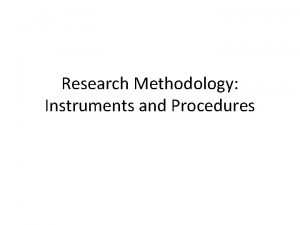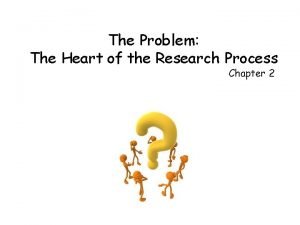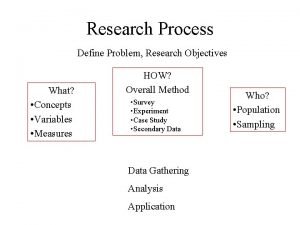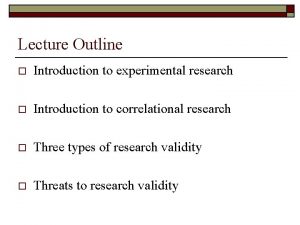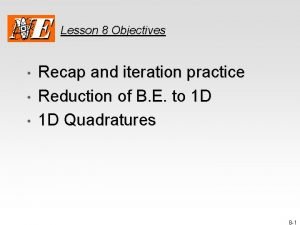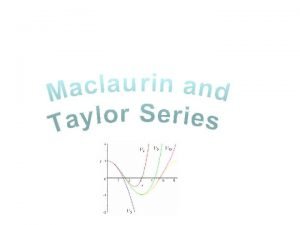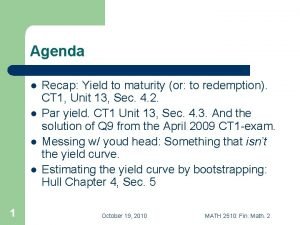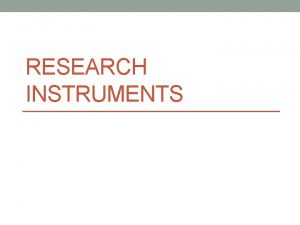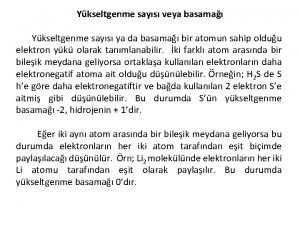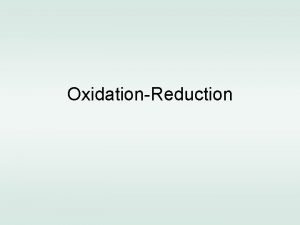Recap Research Says Lesson 7 Definition of Terms























- Slides: 23

Recap Research Says

Lesson 7: Definition of Terms Background of the study

Competencies Recall the guides, Formulate and Discuss the Following: • Definition of Terms • Background of the study

Activity: Presentation of the Group Work last meeting 1. Scope and Limitation of the Study (25 points) 2. Significance of the Study (25 points) 3. Conceptual Framework (text and diagram (50 points)

RUBRICS Indicators Excellent 5 Very Good 4 Good 3 Fair 2 Poor 1 Weight 1. Limitation of the study (scope of variables understudied) X 5 2. Significance of the study (Beneficiary and their benefits) X 5 3. Conceptual Framework (text is coherent and clear) X 5 4. Conceptual Framework (Diagram is coherent & understandable) X 5 Total 100

DEFINITION OF TERMS • Terms that are essential to the study • Terms that should be defined are those found in the title, statement of the problem and sub problems • Define the terms operationally as used in the study (nature of study)

THE HEPATOPROTECTIVE EFFECT OF NEEM (Azadirachta indica) LEAF CRUDE EXTRACT ON ACETAMINOPHEN-INDUCED HEPATOTOXICITY IN MALE RABBITS (Oryctolagus cuniculus)

THE PROBLEM Statement of the Problem The main focus of this study is to determine the heptatoprotective effect of Azadirachta indica (Neem) leaves extract on the liver of male rabbits (Oryctolagus cuniculus) with acetaminophen induced hepatotoxicity. Specifically, this study sought to answer the following queries:

1. What is the profile of Azadirachta indica (Neem) based on the following: 1. 1 Taxonomic Classification; 1. 2 Classificatory Characteristics; 1. 3 Chemical Components and Folkloric/Medicinal Uses? 2. What is the profile of the male rabbit/s in terms of: 2. 1 Taxonomic classification; and 2. 3 Experimental rabbits (initial weight, Acetaminophen Dose and Treatment Dose)?

3. What is the mean liver enzyme levels (Alanine Aminotransaminase (ALT) and Aspartate Aminotransaminase (AST)) of the male rabbits in the following groups before the treatments were induced: 3. 1 Negative Control Group; 3. 2 Positive Control Group; and 3. 3 Experimental Group? 4. What is the mean liver enzyme levels (Alanine Aminotransaminase (ALT) and Aspartate Aminotransaminase (AST)) of the male rabbits in the following groups after the treatments were induced: 4. 1 Negative Control Group; 4. 2 Positive Control Group; and 4. 3 Experimental Group?

5. Is there a significant difference in mean liver enzyme levels (Alanine Aminotransaminase (ALT) and Aspartate Aminotransaminase (AST) ) of the male rabbits before and after the treatments were induced in the following groups: 5. 1 Negative Control Group; 5. 2 Positive Control Group; and 5. 3 Experimental Group? 6. Is there a significant difference in mean liver enzyme levels (Alanine Aminotransaminase (ALT) and Aspartate Aminotransaminase (AST) ) of the male rabbits in the three groups based on the Liver Function Test results after treatments were induced?

DEFINITION OF TERMS To fully understand the terms used in this study, they are defined operationally: Acetaminophen – a non-steroidal anti-inflammatory drug (NSAID), also known as paracetamol, sold without the need of a prescription and used to treat fever and pain. Alanine aminotransferase (ALT) –also known as serum glutamicpyruvic transaminase (SGPT), is an enzyme normally found in the liver but released to the bloodstream when the liver is damaged. Aspartate aminotransferase (AST) – also known as serum glutamicoxaloacetic transaminase (SGOT), is an enzyme normally found in the liver, heart, red blood cells or muscle tissue. It is released into the bloodstream when liver damage occurs, which is why it is commonly measured clinically as an indicator for liver damage.

Before Treatment – the instance when ALT and AST serum levels are measured before administration of treatments, which is also the same instance After Damage, the time when ALT and AST levels are measured 24 hours after induction of hepatotoxicity. Experimental Group –composed of three rabbits that each received oral doses of acetaminophen 2 g/kg body weight + A. indica leaves extract 400 mg/kg of body weight as treatment Hepatotoxicity – liver damage caused by intake of acetaminophen

Hepatoprotective- preservative and carative effects of Neem to the liver of male rabbits Leaf Extracts – refers to the liquid component of Neem plant, known to possess chemical as well as medicinal constituents. Liver necrosis – death of functional liver cells due to chemicals or pathogens Liver Function Test (LFT) – a test used to measure the levels of liver enzymes ALT and AST present in the blood serum, indicating the extent of liver damage Negative Control Group –composed of three rabbits of which each received oral doses of acetaminophen 2 g/kg body weight (bw) and were treated with distilled water only Positive Control Group –composed three rabbits that each received oral doses of acetaminophen 2 g/kg of body weight +Essentiale Forte 1 capsule (300 mg) x 3 doses/day as treatment Plant Profile – refer to the taxonomic classification, category based on Linaen system; and folkloric/medicinal uses of the Neem.

BACKGROUND OF THE STUDY - Is also known as rationale or Introduction in some research types - Presents a over all picture of the need to conduct the study - It ushers to the significant information on variables - It tells a story/status or statistics of the world, country, and local community

THE HEPATOPROTECTIVE EFFECT OF NEEM (Azadirachta indica) LEAF CRUDE EXTRACT ON ACETAMINOPHEN-INDUCED HEPATOTOXICITY IN MALE RABBITS (Oryctolagus cuniculus)

BACKGROUND OF THE STUDY The world is plagued with so much health problems and high cost of medicine. The World Health Organization (WHO, 2015) tallied around 60% of death is caused by health diseases and are untreated due to unavailability of drugs or its high cost. The Philippines is a country rich in natural resources but it is also a place where poverty is rampant with an incidence of 62. 91% of its population (Kurian, 2010). Added to this, the cost of medication is very high and comprises the highest percentage of out-of-pocket expenditure among all the healthcare elements.

In Cebu, the Department of Health (2014), noted that chronic liver diseases listed as one of the top ten causes of death by noncommunicable disease with a death toll of 15, 774 Filipinos in the year 2012. The liver is the largest internal organ in the human body. Moreover, the liver is the biochemical center of the body, responsible for metabolism, detoxification and secretory function in the body. An example of liver damage due to drug ingestion is hepatotoxicity caused by acetaminophen. Acetaminophen is one of the most sellable but misused over-the-counter medicines in the country. It is also one of most hepatotoxic drugs. Although it is safe at therapeutic doses, it has dangerous adverse effects when misused. Alcohol use also increases the risk of acetaminophen induced liver damage even at therapeutic dose (Clin, 2000).

Since ancient era, herbal therapy remained as medicine’s backbone which is economic, safer and easily available to most of people in world. Among diverse herbal treasure, Azadirachta indica (Neem) is a highly esteemed tree with several beneficial properties and applications especially known for its incredible therapeutic and ethnomedicinal values for humankind (Kurian, 2010).

The researcher being an avid science enthusiast who envisioned himself to become a doctor of Medicine someday and whose interest is in the field of Botany, Biochemistry, Pharmacognosy, Pharmacology and Anatomy, the proponent of this study is interested to undertake this investigation to find out possible therapeutic effect of plants. It is on this premise that the proponent initiated this investigation for the purpose of finding the possible use of neem leaf for prevention and cure of liver damage.

Reminders: The background of the study should be 2 pages only and maximum of 6 paragraphs. Follow the rules in parenthetical citation (APA style, paraphrased)

APPLICATION: Based on your approved and edited title, statement of the problem, sub-problems and hypothesis, in 60 mins assign your members to write the following: 1. Definition of Terms (10 pts) 2. Background of the study (40 pts) The output has to be controlled and checked and should be finalized before submission. Coherence is a must. 4. Prepare a powerpoint presentation 5. Assign a presenter next meeting

RUBRICS Indicators Excellent 5 Very Good 4 Good 3 Fair 2 Poor 1 Weight 1. Definition of Terms X 2 2. Background of the study (Coherent, well phrased and has sources of information) X 8 Total 50
 It is part where you indicate the research instrument
It is part where you indicate the research instrument Rubrics definition
Rubrics definition Definition of terms in research paper
Definition of terms in research paper Example of objectives in research
Example of objectives in research Operational definition psych
Operational definition psych Like terms and unlike terms in polynomials
Like terms and unlike terms in polynomials What are the like terms in the algebraic expression
What are the like terms in the algebraic expression Shawshank redemption summary
Shawshank redemption summary Chapter 8 of the great gatsby summary
Chapter 8 of the great gatsby summary What is price matching
What is price matching What is the purpose of an iteration recap?
What is the purpose of an iteration recap? Recap intensity clipping
Recap intensity clipping 60 minutes recap
60 minutes recap Recap database
Recap database Bracket power rule
Bracket power rule Recap introduction
Recap introduction Recap introduction
Recap introduction Recap from last week
Recap from last week Act 1 discussion questions the crucible
Act 1 discussion questions the crucible Pontius pilate allusion
Pontius pilate allusion Logbook recap example
Logbook recap example Ytm recap
Ytm recap Black box recap
Black box recap Fractions recap
Fractions recap
